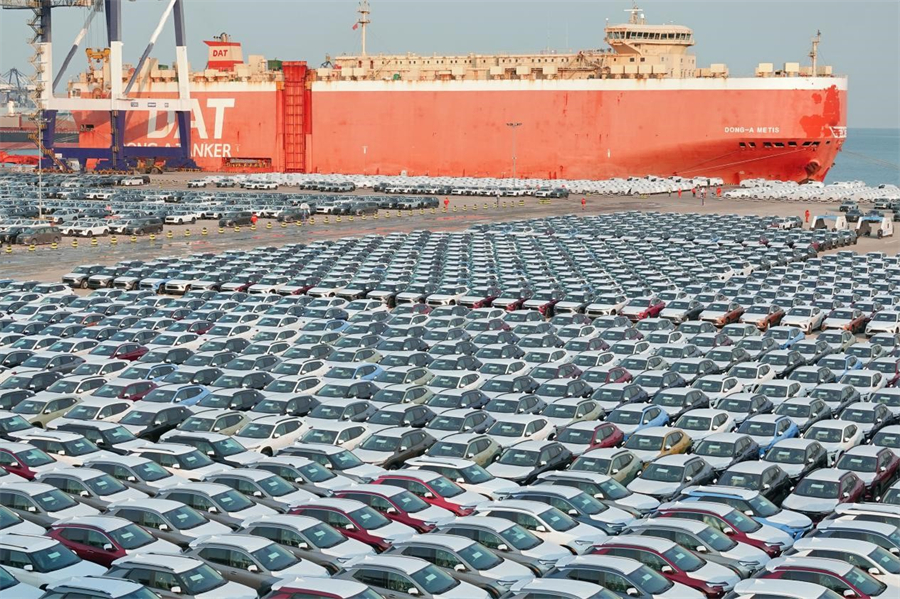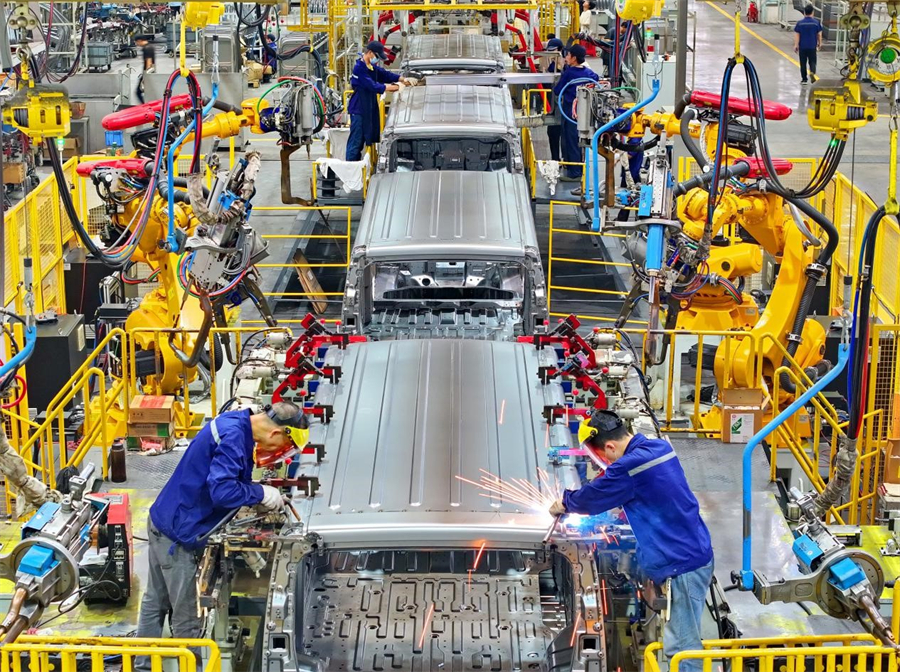China's auto production and sales report strong growth

Chinese-made vehicles are ready for shipment and export at Yantai Port in east China's Shandong province, on Jan. 8, 2024. [People's Daily Online/Tang Ke]
China's automobile production and sales in 2023 reached 30.161 million and 30.094 million units respectively, surpassing the 30 million mark for the first time, according to data released by the China Association of Automobile Manufacturers (CAAM) on Jan. 11, 2024.
This achievement solidifies China's position as the world's top automobile producer and consumer for 15 consecutive years.
Furthermore, China maintained its global leadership in the production and sales of new energy vehicles (NEVs) for the ninth consecutive year, with over 9 million units produced and sold in 2023.
In the same year, China's automobile exports approached 5 million units, representing a significant increase compared to the previous year.
"This new record is the result of the collective efforts of the entire auto industry," said Fu Bingfeng, executive vice president and secretary general of the CAAM.
China's ability to produce and sell over 30 million vehicles highlights its substantial market advantage and consumption potential.
In recent years, China has been steadfast in developing NEVs, constantly making breakthroughs in core technologies and expanding the market size. It took the country 27 years to produce the first 10 million NEVs, and only 17 months to reach the milestone of 20 million, showcasing an impressive "China speed."

Industrial robots collaborate with welders in the welding workshop of a commercial new energy vehicle manufacturer located in the Economic and Technological Development Zone of Ganzhou city, east China's Jiangxi province. [People's Daily Online/Zhu Haipeng]
In 2023, China produced and sold 9.587 million and 9.495 million units of NEVs, respectively, representing a year-on-year growth rate of 35.8 percent and 37.9 percent. China accounted for over 60 percent of global NEV sales.
As of the end of 2023, NEVs in use rose to 20.41 million in China, according to data released by China's Ministry of Public Security on Jan. 11, 2024.
While embracing industrialization and marketization, China's NEV industry is now embarking on a new phase of extensive and high-quality growth, propelling the global auto industry into a new era of electrification and intelligence.
According to data from the CAAM, China's automobile exports reached 4.91 million units in 2023, marking a year-on-year growth of 57.9 percent. This impressive growth can be attributed to Chinese car companies' emphasis on international expansion and their competitive edge in the new energy vehicle sector.
New energy vehicles, which have become a prominent symbol of China's manufacturing prowess, have played a crucial role in propelling the steady expansion of the Chinese auto industry on the global stage.
Zhang Jinhua, secretary-general of the China Society of Automotive Engineers, noted that Chinese new energy vehicle technology and products have become a crucial force supporting the transformation of the global auto industry. The establishment of China's NEV ecosystem will play a vital role in strengthening the synergy between domestic and international markets and resources.
Currently, Chinese car manufacturers are actively investing in overseas production facilities as part of their long-term global expansion plans.

A woman takes a test drive of a new energy vehicle during a NEV promotion event held in Lishui district of Nanjing, east China's Jiangsu province, on Aug. 22, 2023. The event featured NEVs from 23 manufacturers. [People's Daily Online/Zhu Hongsheng]
Liu Luochuan, director of the Strategic Development Research Center at Dongfeng Motor Corp., foresees deepening localization of Chinese automobiles in foreign markets, accompanied by a rise in the number of overseas production bases.
By 2030, an estimated 50 percent of China's overseas automobile sales will come from trade exports, while the other half will be generated by sales from overseas factories. Additionally, there will be a growing proportion of new energy vehicle exports contributing to this trend.
"China's auto supply chain not only contributes to the global auto industry through trade but also plays a role in shaping the layout of the global supply chain through investment," said Zhang Yongwei, vice president of China EV100, an electric vehicle industry think tank.
Taking power batteries as an example, as of now, Chinese auto manufacturers have surpassed a cumulative planned capacity of 500 gigawatt-hours (GWh) overseas.
China's auto industry has gained a global competitive edge, thanks to its robust domestic market and well-established industrial and supply chains. New brands in the intelligent NEV sector have emerged, including NIO, Li Auto, AITO, and Xpeng, leaving their mark on the global auto market.
China's auto market has significant growth potential, fueled by factors like vehicle ownership per 1,000 people and the demand for car upgrading and trade-ins. The CAAM predicts that car sales in China will surpass 31 million units by 2024.
Miao Wei, vice-chairman of the Committee on Economic Affairs of the National Committee of the Chinese People's Political Consultative Conference (CPPCC), believes that China's target of having new energy vehicles account for over 50 percent of total sales by 2035 could be achieved as early as 2025, or at the latest by 2026.
























